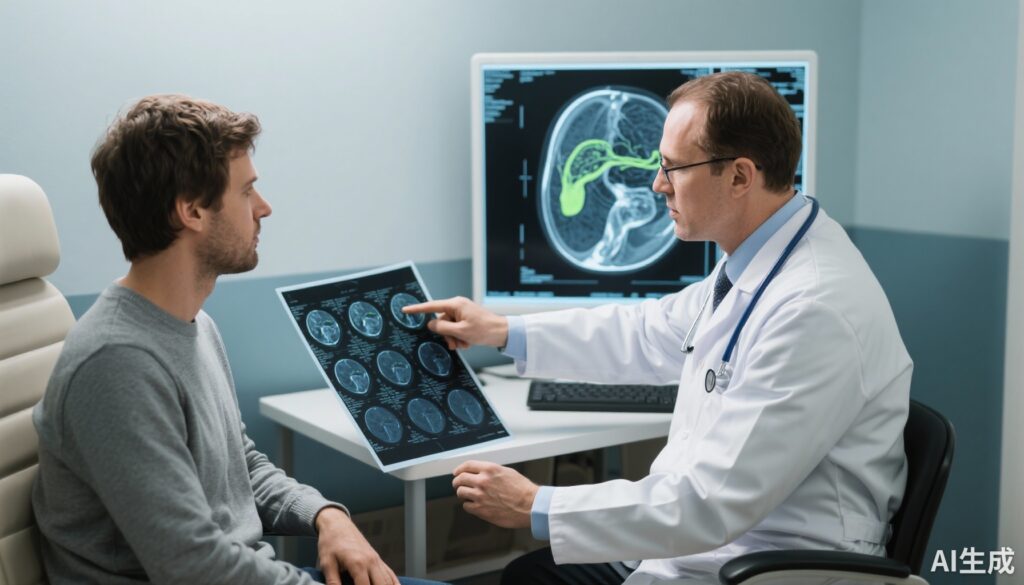Patient Information
A 45-year-old Caucasian male presented to the hepatology clinic with complaints of progressive pruritus and fatigue over the past three months. He reported intermittent right upper quadrant discomfort but denied jaundice or weight loss. Past medical history was notable for ulcerative colitis diagnosed five years prior, currently in clinical remission on mesalamine. There was no history of alcohol abuse or viral hepatitis risk factors. Family history was negative for liver disease.
On physical examination, the patient appeared well, without scleral icterus or hepatosplenomegaly. Dermatological examination revealed excoriations consistent with scratching due to pruritus.
Diagnosis
Initial laboratory investigations revealed a cholestatic pattern: elevated alkaline phosphatase (ALP) at 380 IU/L (normal 40-130), gamma-glutamyl transferase (GGT) 240 IU/L (normal 12-64), mildly raised bilirubin of 1.8 mg/dL (normal 0.3-1.2), and mild transaminitis (AST 55 IU/L, ALT 60 IU/L). Complete blood count and coagulation tests were within normal limits.
Serology for hepatitis A, B, and C viruses was negative. Autoimmune markers including anti-mitochondrial antibody (AMA) were negative. Antinuclear antibodies (ANA) demonstrated low titer positivity (1:80), and perinuclear anti-neutrophil cytoplasmic antibodies (p-ANCA) were positive, consistent with underlying inflammatory bowel disease.
Imaging with magnetic resonance cholangiopancreatography (MRCP) demonstrated multifocal strictures and segmental dilatations involving both intrahepatic and extrahepatic bile ducts, characteristic of sclerosing cholangitis. Liver biopsy revealed periductal concentric (‘onion skin’) fibrosis confirming the diagnosis of primary sclerosing cholangitis (PSC).
Differential Diagnosis
– **Secondary sclerosing cholangitis:** Ruled out due to absence of prior biliary tract surgery, trauma, or infection.
– **Primary biliary cholangitis (PBC):** Unlikely given negative AMA and the cholangiographic findings involving both intra- and extrahepatic ducts.
– **Cholangiocarcinoma:** No dominant strictures or mass lesions on imaging; tumor markers (CA 19-9) within normal limits.
– **Drug-induced cholestasis:** No recent medication changes or hepatotoxic drug exposure.
Treatment and Management
The patient was started on ursodeoxycholic acid (UDCA) at a dose of 15 mg/kg/day to potentially improve liver biochemistry, although its benefits in PSC are controversial. Symptomatic management of pruritus included cholestyramine 4 grams twice daily, which provided partial relief.
Close monitoring for disease progression and complications was instituted, including regular liver function tests, imaging surveillance for cholangiocarcinoma, and colonoscopy given comorbid ulcerative colitis.
Given the progressive nature of PSC and eventual risk of liver failure, discussions about liver transplantation were initiated for the future if indicated.
Outcome and Prognosis
At six-month follow-up, the patient reported moderate improvement in pruritus; liver function tests showed stable but persistently elevated cholestatic enzymes. There was no clinical or radiological evidence of dominant strictures or malignancy.
Long-term prognosis for PSC remains guarded, with many patients progressing to cirrhosis or requiring liver transplantation over 10-15 years. The coexisting inflammatory bowel disease requires continued surveillance due to increased colorectal cancer risk.
Discussion
This case highlights a typical presentation of primary sclerosing cholangitis in a middle-aged male with underlying ulcerative colitis, emphasizing the strong association between PSC and inflammatory bowel disease. The characteristic cholangiographic features of multifocal bile duct stricturing and the classic histological ‘onion skin’ fibrosis were central to diagnosis.
PSC is a chronic cholestatic liver disease of unknown etiology characterized by inflammation and fibrosis of intrahepatic and extrahepatic bile ducts. It has an unpredictable clinical course with progression to liver failure or cholangiocarcinoma. Current treatment options are limited; UDCA may improve biochemical markers, but robust evidence for mortality benefit is lacking. Symptom management and vigilant surveillance for complications remain paramount.
This case underscores the importance of considering PSC in patients with cholestatic liver enzymes and inflammatory bowel disease, as early diagnosis facilitates monitoring and timely referral for liver transplantation.
Expert commentary: Diagnosing PSC can be challenging because of variable symptoms and overlap with other cholestatic diseases. MRCP is the imaging modality of choice to visualize the characteristic bile duct changes noninvasively, avoiding the risks of endoscopic retrograde cholangiopancreatography unless therapeutic intervention is required.
References
1. Chapman R, Fevery J, Kalloo A, et al. Diagnosis and management of primary sclerosing cholangitis. Hepatology. 2010 May;51(5):660-78.
2. Lazaridis KN, LaRusso NF. Primary sclerosing cholangitis. N Engl J Med. 2016 Jan 21;374(1):61-72.
3. European Association for the Study of the Liver (EASL). EASL Clinical Practice Guidelines: Management of cholestatic liver diseases. J Hepatol. 2009;51(2):237-67.
4. Boberg KM, Bergquist A, Mitchell S, et al. PSC-A comprehensive review. J Hepatol. 2006;44:639-53.


